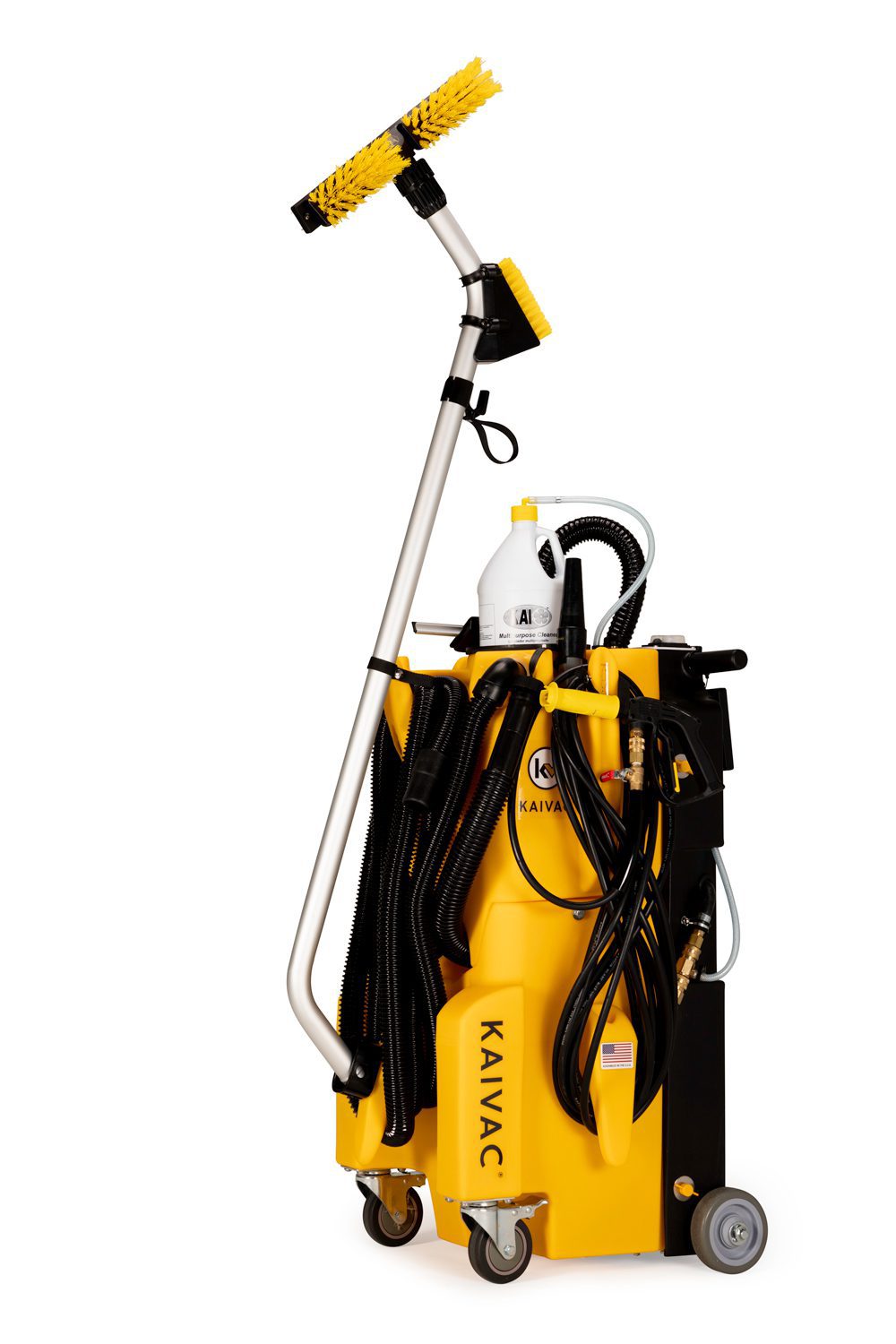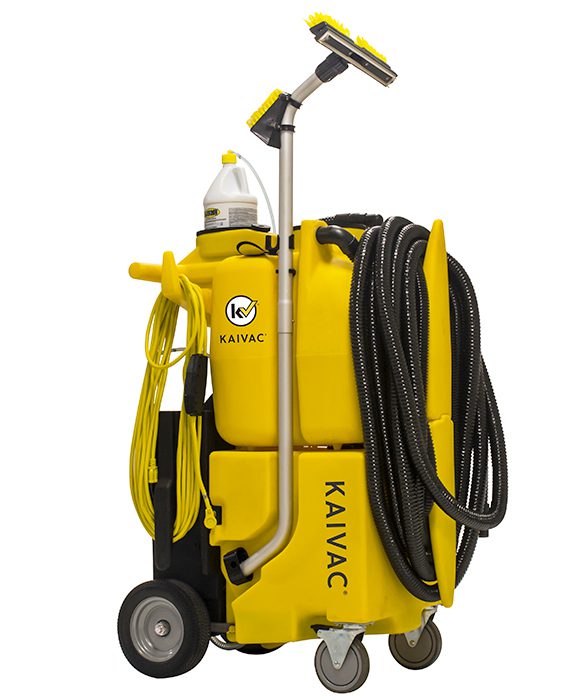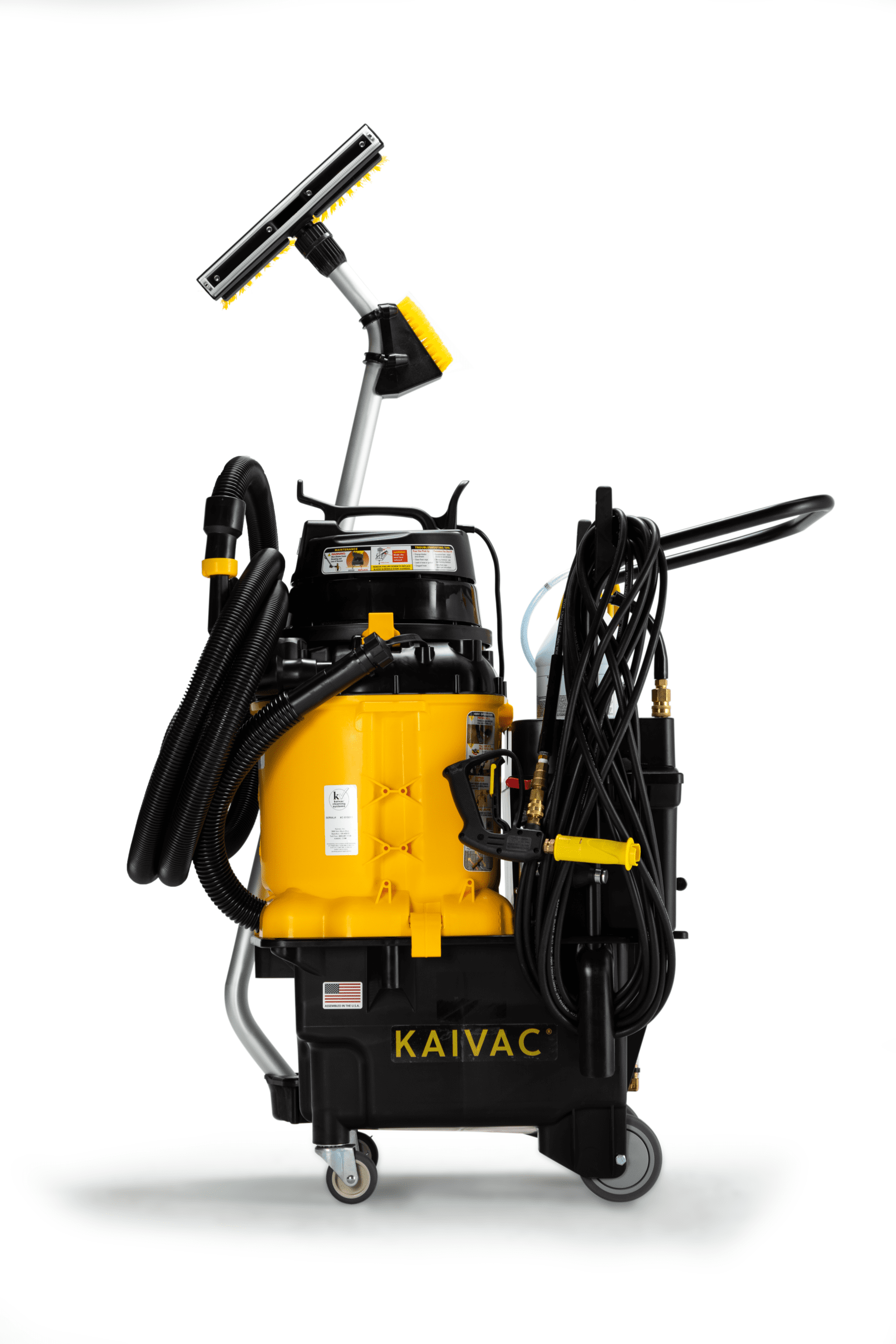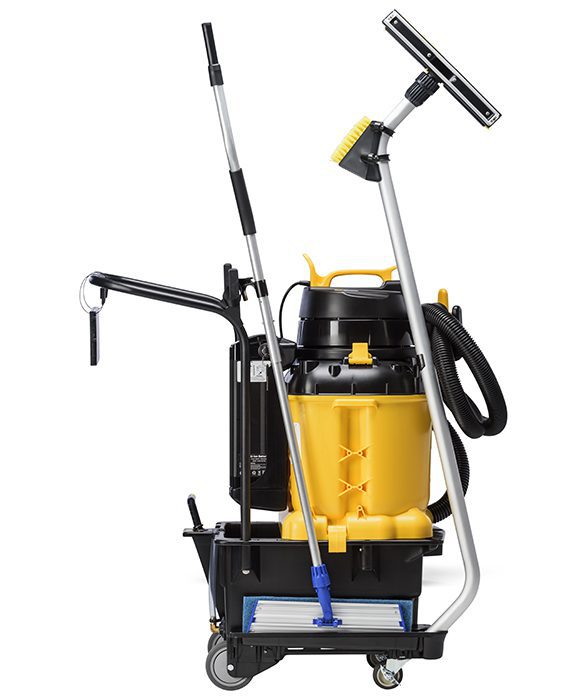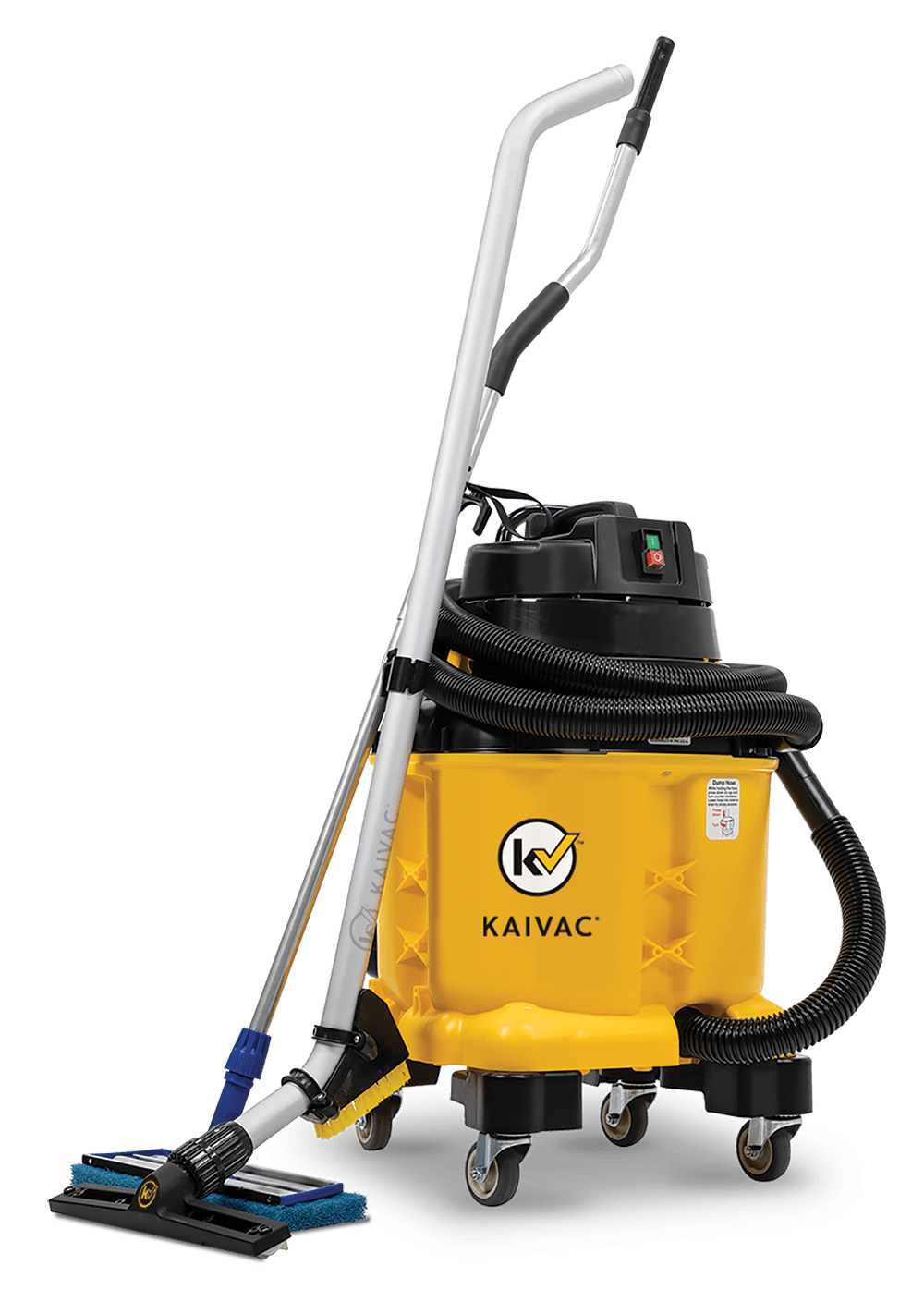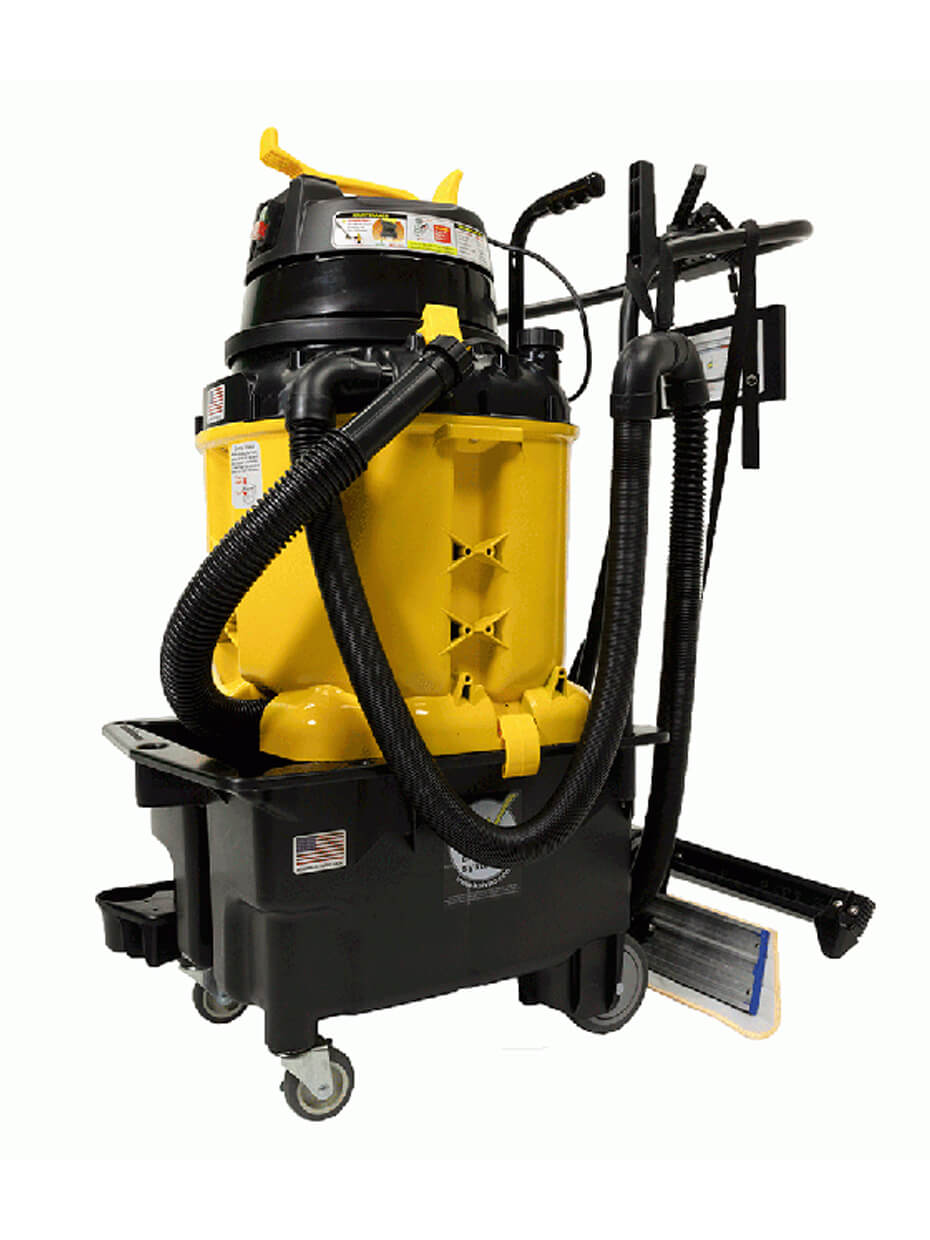Executive Overview
The overall goal of green cleaning is to protect the health and safety of a building’s occupants and workers without harming the environment. This extends well beyond the realm of chemicals to include issues related to cleaning effectiveness, IEQ (indoor environment quality), safety, ergonomics and more.
Kaivac’s No-Touch Cleaning systems have been designed from the start to clean thoroughly in an environmentally responsible manner. Kaivac believes its commercial cleaning systems are among the “greenest” in existence today for the reasons listed below.
Cleaning Chemicals
- Kaivac’s KaiO has been certified by Green Seal.
- Kaivac’s systems utilize metering tips to ensure accurate dilution.
- Kaivac minimizes the number of chemicals required to clean an entire building.
- Kaivac’s systems reduce chemical usage by as much as 66%.
Effective Cleaning
- Kaivac’s systems have been scientifically proven to remove more than 30 times more bio-pollution and to be 60 times more effective at reducing bacterial contamination than mops.
- Kaivac’s continual usage of fresh cleaning solution and rinse water along with complete soil extraction eliminate cross-contamination.
- The efficiency of Kaivac’s floor care program frees cleaning resources that can be applied to other areas of the building.
Indoor Environment Quality (IEQ)
- Kaivac’s cleaning methods improve indoor air quality by removing dust and then eliminating it in a dust-free, liquid form.
- Kaivac’s No-Touch Cleaning systems include HEPA filtration on wet or dry vacuum exhaust as well as the blower function.
- Kaivac extends the time between burnishing, stripping and finishing floors, which minimizes airborne particulate as well as chemical exposure.
- The chemical efficiency of Kaivac systems minimizes fumes.
- Kaivac has reduced the noise levels of its No-Touch Cleaning systems for round-the-clock cleaning.
- Kaivac provides a healthy and practical alternative to the shiny floor myth that helps stretch cleaning resources while improving IAQ (indoor air quality).
The Healthy Worker
- Kaivac systems are ergonomically designed to minimize bending and lifting.
- No-Touch Cleaning methods protect workers from unhealthy exposure to contaminated surfaces and disease transfer points.
- No-Touch Cleaning leaves floors clean and dry to minimize the possibility of slip-fall injuries for maintenance workers and building occupants.
- Kaivac’s systems are non-discriminatory in that they empower any worker, regardless of physical condition, to excel on the job.
- No-Touch Cleaning inspires custodial pride and improves job satisfaction.
Introduction
Over the last several years, the concept of green cleaning has been gaining momentum in the marketplace. However, there currently is no standard definition of the term that is agreed upon across the industry, leaving it open to misinterpretation or even abuse by marketing hype. Buyers are generally on their own to deduce its meaning and significance. As a result, many assume that green cleaning is solely an issue of chemistry. However, Kaivac believes that green cleaning encompasses a number of other aspects as well, including:
- Indoor air quality
- Noise pollution
- Cleanliness
- Productivity
- Ergonomics
- Safety and more
The overall goal of green cleaning is to protect the health and safety of a building’s occupants and workers without harming the environment. Regardless of definition, Kaivac’s No-Touch Cleaning systems are designed from the start to clean thoroughly in an environmentally responsible manner. In fact, the molds of the machines themselves are made of 100% recyclable polyethylene. In addition, they achieve their results using cold water.
This article offers Kaivac’s position on green cleaning and discusses the various reasons that Kaivac believes its commercial cleaning systems are among the greenest in existence today.
Chemicals
There is no doubt that chemicals play a major role in green cleaning. But their relevance goes far beyond the issue of correct chemistry. Kaivac believes that other chemical-related issues are equally important. These issues include:
- Ensuring proper dilution ratios
- Reducing the number and variety of chemicals used in a cleaning process
- Reducing the amount of chemicals required to remove soils in order to achieve the desired cleanliness levels
Environmentally Friendly Chemistry
KaiO has been certified by Green Seal, a third party non-profit independent organization dedicated to achieving a healthier, cleaner environment to be:
- Safer to use than other more traditional cleaning chemicals used for the same or similar purpose
- Just as effective as traditional cleaning chemicals
Proper Dilution
It doesn’t matter how safe the formula of a chemical is if it isn’t applied in the proper proportion. Kaivac systems utilize a system of color-coded metering tips to ensure accurate dilution of chemicals from one, two, four, eight, and 20 ounces per gallon. All of our chemical bottles include up-to-date charts to help match color tips with appropriate dilution.
Fewer is Better
In the past, many cleaning professionals believed it was necessary to use specialized products for different surfaces and areas within a building. This was often encouraged by chemical and equipment vendors. This resulted in cleaning procedures that specified using seven or eight different chemicals for a restroom alone. Talk about multiplied costs and inefficiencies!
Kaivac believes that fewer is better when it comes to cleaning chemicals. The true multipurpose nature of KaiO reflects this belief for training, safety and management reasons.
Research shows that simplifying the work routine by using fewer multipurpose products can result in strong positive benefits, including:
- Fewer Mistakes: Less risk of using the wrong chemical or mixing chemicals which could cause physical injury or costly damage.
- Less Training Time: Workers don’t have to be trained on as many different products and SDS requirements.
- Reduced Inventory: Fewer under-utilized chemicals tying up space and capital as well as creating a potential for accidents. Also, packaging and transport requirements are reduced.
- Smoother Work Flow: Fewer interruptions caused by having to retrieve specialized chemicals from the janitor’s room.
- Higher Employee Satisfaction: Simplification reduces workers’ confusion and stress, resulting in better morale, lower turnover and a safer situation.
- Greater Productivity: More time spent doing the actual job, rather than training, deciding which product to use, product handling, etc.
Less is More
Chemical efficiency is always a design requirement of Kaivac systems. For example, Kaivac’s No-Touch Cleaning processes combine built-in dwell time with the blasting action of its pressure washer in order to minimize the need for chemicals while cleaning. Also, Kaivac’s QuickDraw™ instant chemical injection accessory eliminates any chemical waste while drawing or purging chemicals during cleaning procedures. The built-in, extended dwell time of this process enables the finish-friendly cleaning solution to penetrate and float soils for easy removal.
In addition, Kaivac’s floor care systems reduce chemical usage by as much as 66% compared to traditional mops and auto scrubbers. This is not only environmentally responsible, but it saves money.
Effective Cleaning
The more we understand about how disease is transferred, the clearer becomes the importance of cleaning to the protection of health. In fact, many healthcare professionals and environmental scientists consider cleaning to be our first line of defense against infectious disease.
Kaivac uniquely balances the environmental considerations of green cleaning with cleaning efficiency and effectiveness. Our technologies and practices thoroughly remove potentially harmful soils, bacteria and other bio-pollutants in order to produce and maintain a truly healthy indoor environment.
No-Touch Cleaning
Kaivac’s No-Touch Cleaning systems were designed from the beginning for the maximum removal of unwanted matter. These systems combine pressure washer, chemical injection and wet vacuum into a single unit. Workers simply apply cleaning solution to target surfaces, blast-rinse the soils to the floor, then vacuum the floor dry, removing the soils and bacteria.
Unlike mops and wipes, No-Touch Cleaning ensures fresh cleaning solution and clean rinse water. Likewise, they prevent cross contamination between areas of a building, such as between the restroom and the kitchen. In fact, scientific studies show that Kaivac’s process is as much as 60 times more effective than mop and bucket techniques in reducing bacterial contamination on floor and grout surfaces.
Kaivac is committed to the science of cleaning. In addition to conducting our own comprehensive research program, Kaivac is a founding member of the Cleaning Industry Research Institute (CIRI) and a major underwriter of their research.
The Elements of Cleaning (FACTS)
According to ISSA, there are three primary components to the process of cleaning: Agitation, Chemical, and Time/temperature (ACT). They all work together in direct relationship with one another; if one is changed, one or both of the other must change as well. For example, if dwell time is decreased, then either agitation or chemical strength must be increased to compensate.
Kaivac believes that there should be two more components for truly effective cleaning and has adopted the acronym FACTS. The F stands for fresh ingredients and water and the S stands for suctioning away the soils. Always using fresh cleaning solution and rinse water along with the suctioning away of all soils achieves maximum cleanliness while eliminating any threat of cross contamination.
The Myth of Shiny Floors
In response to aggressive marketing by chemical, high speed equipment and buffing pad manufacturers, many facilities assign an unhealthy importance to high gloss floors. Shiny floors may look great, but they require a large investment in floor finishes and strippers, high speed floor equipment, pads and so on. Moreover, the labor involved in scrubbing, burnishing, recoating, stripping, and finishing the floors is even more significant.
In fact, it is estimated by some that as much as 20 percent of a facility’s labor budget is spent on shiny floors.
As a result, all too many facility managers neglect other areas of a building in order to finance their shiny floors. In addition, the associated procedures produce a number of unhealthy byproducts, such as airborne particulates and chemical vapors, which have a negative impact on the indoor environment. And in the end, there is no assurance that the floor is really clean.
Given that a clean matte finish is highly acceptable in the majority of situations, Kaivac believes that cleaning floors deeply with AutoVac Stretch – the auto scrubber alternative – is a more practical, healthy and environment-friendly approach. AutoVac Stretch extends the time between burnishing, stripping and finishing. This enables facility managers to focus more resources towards ensuring that the entire building is clean and healthy.
Indoor Air Quality (IAQ)
The condition of the air is one of the most significant factors in determining the quality of an indoor environment. Poor indoor air quality is known to contribute to allergies, asthma and other respiratory ailments. While a number of factors play a role in the quality of the air within a facility, effective cleaning methods can make a significant difference.
Dust is a major contributor to poor indoor air quality. It is known to be a carrier of various organisms and particles, such as dust mites, pollens, hair, skin cells, food crumbs, bacteria, and more. Ironically, byproducts of certain cleaning equipment and processes can also contribute to poor indoor air quality. These include pulverized or powdered floor finish, which is stirred up into the air, as well as fumes from harsh chemicals, including strippers and finish.
Spread of Lingering Dust from Cleaning
Kaivac’s philosophy of cleaning involves the thorough removal of dust as well as minimizing the need to scrub, burnish, strip and finish floors, all of which factor into the quality of indoor air.
The traditional method of cleaning involves sweeping floors with a dust mop, which leaves all sorts of dust and debris behind. Then, the custodian usually finishes by shaking the dust mop and sweeping any visible soil into a dustpan. Not only does this throw dust and dirt into the air, which can remain airborne for up to two hours, but it leaves even more dirt behind. Many hard-to-reach areas, like light fixtures, high vents, under registers, etc. are rarely touched.
Realizing the shortcomings of traditional dust mopping, many facilities also use auto scrubbers to clean the floors. But auto scrubbers can actually grind away at the floor finish and dull it prematurely. Auto scrubber pads don’t significantly harm finish when they are first installed. However, after only a few moments of use, particulate matter becomes trapped in the pad, which then grinds and scratches the floor finish. This harsh scrubbing action actually pulverizes the top surface and throws it into the air and onto the floor along with dulling the finish.
A burnisher is then required to restore the shine. The sanding action of the burnisher essentially removes the top layer of floor finish and blows it into the air. This degrades indoor air quality further while creating additional work for the cleaning professional — including frequent recoats. Moreover, the propane fuel inside a building poses a risk of explosion as well as Carbon Monoxide exhaust. The frequent stripping and recoating of floors also introduces avoidable chemicals and associated fumes into the building.
Complete Removal of Dust
Kaivac improves indoor air quality by eliminating the need to dust mop as well as extending the time between burnishing, stripping and finishing floors. In addition, Kaivac’s No-Touch Cleaning systems provide a high dusting capability, which enables dust and other soils to be removed from hard to reach areas. This also enables air vents to be cleared for increased ventilation which, in turn, helps improve IAQ. In addition, all Kaivac No-Touch Cleaning systems include HEPA filtration for both wet and dry cleaning.
Noise Pollution
In addition to air quality, other factors, such as noise, affect the indoor environment quality (IEQ). Recent studies indicate that under noisy conditions, people become more fatigued and stressed, and their productivity suffers. Noise can slow recovery for healthcare patients and also contribute to the chaotic work environment found in many hospitals. Loud noise can interfere with normal communication as well as concentration levels. This is true for building occupants as well as maintenance personnel.
Kaivac addresses these issues to appeal to facilities that are sensitive to noise levels. We were the first manufacturer in the industry to invest in innovative baffling and muffling technologies for its cleaning equipment. We reduced the noise levels of our No-Touch Cleaning systems to 65 decibels (dB), which is typically the level of conversation or a muffled dishwasher. Specially made for use in “noise-sensitive” settings, Kaivac’s machines can be used for round-the-clock cleaning in hospitals, nursing homes, dormitories, schools, fast food, and more.
The Healthy Worker
Worker friendliness is one of the primary design principles behind Kaivac’s cleaning systems. We consider what factors will make the worker’s job more effective, faster, simpler, safer and satisfying when developing a system. For example, No-Touch Cleaning systems not only improve the effectiveness and productivity of custodial workers, but they also protect the workers from unhealthy exposure to contaminated surfaces and disease transfer points.
Because of their ergonomic design, the machines protect workers from injury associated with lifting and all-day mopping. They also eliminate the need to crawl around restrooms on hands and knees. The chemical injection system is equipped with a number of safeguards, including proportioning control, bottle safety caps and non-aerosolizing chemical application. Furthermore, because these systems leave floors clean and dry, they protect workers and occupants from slip-fall injuries.
Another employee-related benefit of these systems is that they enable many workers to excel on the job who may otherwise be restricted by physical condition or age. Even more importantly, by improving working conditions and raising the standard of custodial performance, No-Touch Cleaning inspires worker pride and job satisfaction.

